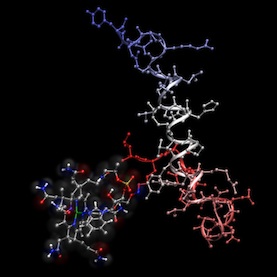The ultimate goal is hPYY medication that obese people can take orally
Researchers plan to create chewing gum that sneaks an appetite-suppressing hormone through the gut and into the blood
Losing weight is not always about anticipating swimsuit season or squeezing into skinny jeans—for the clinically obese, losing weight is about fighting serious illness and reclaiming health. But the primal part of the brain that regulates appetite will not place a moratorium on hunger just because someone and their doctor acknowledge the need to lose weight. Researchers at Syracuse University are working toward a unique solution: a stick of chewing gum that suppresses appetite.
There are many appetite-suppressing drugs on the market, a large number of which are based on stimulating amphetamines that carry the risk of serious side effects such as high blood pressure and heart failure. Syracuse Chemist Robert Doyle’s research focuses on a hormone called human peptide YY (hPYY), which is released from cells that line the intestine whenever you eat and exercise. The more calories consumed, the more hPYY travels from intestinal cells into the bloodstream, eventually reaching the hypothalamus—an almond-size, evolutionarily ancient part of the brain that helps to regulate hunger, thirst, body temperature and sleep cycles.
Previous studies have shown that injections of hPYY suppress appetite in rodents, monkeys and people. In one study, both obese and lean people consumed about 30 percent fewer calories than usual at a buffet lunch only two hours after receiving a dose of hPYY.
Doyle wanted to know if hPYY still works when taken orally because pills and tablets are easy and painless compared with injections. The problem is that if you ingest pure hPYY, the caustic soup of acids and digestive enzymes in your stomach and intestine will destroy the hormone before it reaches your blood. In the body, intestinal cells secrete a precursor to hPYY that is transported into the blood and sliced into the right molecular shape in ways that are not well understood.
Doyle knew exactly how to protect hPYY in the stomach and gut. In earlier work, he found a way to safely ferry the hormone insulin through the digestive system by chemically linking insulin to vitamin B12. Since we do not produce B12 on our own, we have evolved a complex bucket brigade of molecules that ushers the essential vitamin on a journey from the food in our mouth to the bloodstream, where it nourishes all our cells. Doyle used this same trick with hPYY.
After bonding hPYY to vitamin B12, Doyle pumped a stream of the chemical couple directly into the stomachs of healthy rats. When he sampled the rats’ blood for several hours after the feeding, he found levels of hPYY high enough to suppress appetite in a human adult. The findings show that B12 grants hPYY safe passage from the stomach to the bloodstream, as discussed online in the Journal of Medicinal Chemistry in November. Next, Doyle hopes to show that hPYY pumped into the stomachs of obese rats reduces their appetite and how many calories they consume.
The ultimate goal is hPYY medication that obese people can take orally in pill or tablet form—or even as chewing gum. Because recent research suggests there are PYY receptors in the tongue, hPYY chewing gum could promote feelings of satiety even sooner than hPYY pills.
Read more . . .










